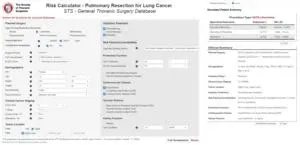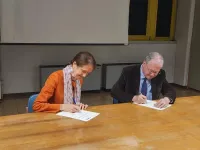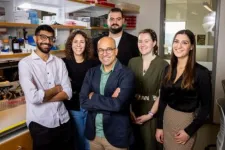(Press-News.org) CHICAGO, IL – October 17, 2024 – The Society of Thoracic Surgeons (STS) announces the release of two new risk calculators to inform physician-patient decision-making in thoracic surgery. Engineered using contemporary data from the STS General Thoracic Surgery Database, these interactive tools provide surgeons with accurate, preoperative risk estimations for outcomes of esophagectomy for cancer and pulmonary resection for lung cancer.
The mobile-friendly risk calculators allow surgeons and multidisciplinary medical providers to estimate a patient’s individualized risk in real-time, based on specific factors such as tumor characteristics, comorbidities, and procedures performed. As patient factors are added by the user, the risk estimates of morbidity and mortality are dynamically calculated along with 95% confidence intervals. The goal is to provide thoracic surgeons with simple-to-use, intuitive resources that can support preoperative decision-making and improve quality of care.
The new esophagectomy for cancer risk calculator is powered by enhanced STS esophagectomy for cancer risk models using data from 18,503 patients across 254 hospitals between January 2015 and December 2022. This cohort is four times larger than that used in previous models, resulting in more precise estimations and broader applicability. Key updates include the incorporation of new risk factors such as preoperative cancer staging and body surface area.
“The esophagectomy for cancer risk calculator represents a significant advancement in personalized care for thoracic surgery patients,” said STS President Jennifer C. Romano, MD, MS. “Informed by a more diverse patient cohort, and using preoperative variables, the tool provides surgeons and patients with a comprehensive and informed view of predicted outcomes.”
Similarly, the pulmonary resection for lung cancer risk calculator is based on updated STS risk models using data from 140,927 patients at 337 hospitals from 2015 to 2022. This model reflects modern thoracic surgical trends and techniques, including the growing prevalence of minimally invasive and robot-assisted procedures.
"The new risk calculator for pulmonary resection of lung cancer offers superior performance and applicability, especially for high-risk patients," added Dr. Romano. “It serves as a valuable tool for both clinical decision-making and improving patient outcomes.”
The new thoracic surgery risk calculators are the next in a series of enhancements to the STS National Database™ designed to meet the day-to-day needs of surgeons, data managers, and cardiothoracic care teams. Additional thoracic surgery risk calculators focused on long-term outcomes are planned for release in 2025. The STS National Database™ is one of the largest and most comprehensive clinical registries with nearly 10 million cardiothoracic procedures performed by 4,300+ surgeons.
The new online tools are part of a suite of risk calculators for adult cardiac and thoracic surgery. Access the risk calculators here.
About STS
Founded in 1964, The Society of Thoracic Surgeons is a not-for-profit organization representing more than 7,800 cardiothoracic surgeons, researchers, and allied healthcare professionals worldwide who are dedicated to ensuring the best possible outcomes for surgeries of the heart, lung, and esophagus, as well as other surgical procedures within the chest. The Society’s mission is to improve the lives of patients with cardiothoracic diseases.
# # #
END
FAPESP representatives visited the headquarters of Italy’s Consiglio Nazionale delle Ricerche (CNR) in Bologna on October 16th to sign a new work plan that will enable the implementation of a cooperation agreement signed by the institutions in December 2023.
The aim is to enable joint funding of research projects in the following areas: Cultures, Inmaterial Heritage, Interdisciplinary Networks; Agri-food and Sustainable Development; Technology and Innovation; and Health and the Environment.
Researcher mobility and ...
DURHAM, N.C. – Scientists don't just want their results to be published; they want them to be published in the most influential journal they can find. This focus on a high 'impact factor' is driven by their concerns about promotion and tenure, but it may be overlooking the important role that smaller publications can play in the advancement of their science.
A new paper, “Role of low-impact-factor journals in conservation implementation,” appearing Oct. 17 in the journal Conservation ...
In its first three years of operation, Medicaid’s primary care-focused Accountable Care Organizations (ACOs) in Massachusetts showed “no clear evidence of success” in improving asthma care for children, according to research led by the University of Massachusetts Amherst and UMass Chan Medical School-Baystate Health.
The study, published recently in JAMA Pediatrics, compared the asthma care of Medicaid-insured children affiliated with a Medicaid ACO to that of children with private insurance. Senior author Dr. Sarah Goff, a practicing pediatrician and internist ...
FOR MORE INFORMATION
Michael San Filippo
Senior Media Relations Manager
American Veterinary Medical Association
Cell/Text: 847-732-6194
msanfilippo@avma.org
New study sheds light on lily toxicity in cats; outpatient treatment may be viable option
(SCHAUMBURG, Illinois) October 17, 2024—A study published recently in the Journal of the American Veterinary Medical Association (JAVMA) has revealed new insights into the treatment of cats exposed to toxic lilies, offering hope for pet owners facing this common household hazard.
The study (“Prevalence of acute kidney ...
Scientists hope that quantum computing will help them study complex phenomena that have so far proven challenging for current computers – including the properties of new and exotic materials. But despite the hype surrounding each new claim of “quantum supremacy”, there is no easy way to say when quantum computers and quantum algorithms have a clear and practical advantage over classical ones.
A large collaboration led by Giuseppe Carleo, a physicist at the Swiss Federal Institute for Technology (EPFL) in Lausane and the member of the National Center for Competence in Research NCCR MARVEL, has now ...
If you’ve ever struggled to reduce your carb intake, ancient DNA might be to blame.
It has long been known that humans carry multiple copies of a gene that allows us to begin breaking down complex carbohydrate starch in the mouth, providing the first step in metabolizing starchy foods like bread and pasta. However, it has been notoriously difficult for researchers to determine how and when the number of these genes expanded. Now a new study led by The University of Buffalo (UB) and The Jackson Laboratory (JAX) showcases how early duplications of this ...
The biosynthetic pathway of specific steroidal compounds in nightshade plants (such as potatoes, tomatoes and eggplants) starts with cholesterol. Several studies have investigated the enzymes involved in the formation of steroidal glycoalkaloids. Although the genes responsible for producing the scaffolds of steroidal specialized metabolites are known, successfully reconstituting of these compounds in other plants has not yet been achieved. The project group ‘Specialized Steroid Metabolism in Plants’ in the Department of Natural Product Biosynthesis, led by Prashant Sonawane, who is now Assistant ...
A major new study reveals that carbon dioxide (CO2) emissions from forest fires have surged by 60% globally since 2001, and almost tripled in some of the most climate-sensitive northern boreal forests.
The study, led by the University of East Anglia (UEA) and published today in Science, grouped areas of the world into ‘pyromes’ - regions where forest fire patterns are affected by similar environmental, human, and climatic controls - revealing the key factors driving recent increases in forest fire activity.
It is one of the first studies to look globally at the differences between forest ...
A new study shows that an artificial intelligence (AI) tool can help people with different views find common ground by more effectively summarizing the collective opinion of the group than humans. By producing statements that convey the majority opinion, while incorporating the minority’s perspective, the AI produced outputs that participants preferred—and that they rated as more informative, clear, and unbiased, compared to those written by human mediators. Human society is enriched by a plurality of viewpoints, but agreement is a prerequisite for people to act collectively. ...
The health of American democracy is facing challenges, with experts pointing to recent democratic backsliding, deepening partisan divisions, and growing anti-democratic attitudes and rhetoric. In this issue of Science, Research Articles, a Policy Forum, a Science News feature, and a related Editorial highlight how the tools of science and technology are being used to address this growing concern and how the upcoming U.S. presidential election could impact U.S. science.
In one research study in this special issue, Jonathan Chu and colleagues sought to understand whether understandings ...




